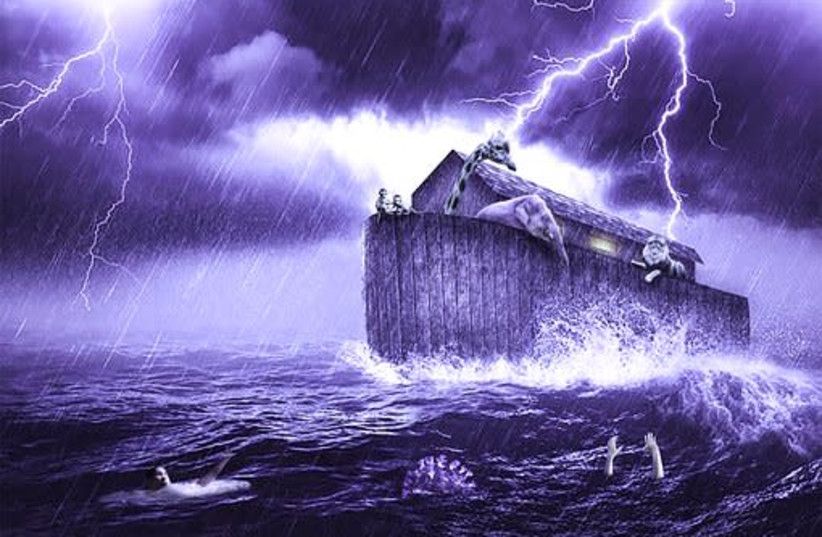Nephilim are giants of biblical mythology, dotting legends of both Jews and Christians alike.
Their nature is vague and uncertain, as is their origin, due in no small part to how apocryphal much of the information about them is.
Regardless, they are widely understood to be large and mysterious entities who possess great power.
So what do we know about the Nephilim? Are they giants? Do they descend from angels or fallen angels? Was the famous giant Goliath one such entity?
Here is everything you should know.

What does the Bible say about Nephilim?
The phrase "Nephilim" appears in three locations in the Bible. Once in the Book of Genesis, once in the Book of Numbers and another in the Book of Ezekiel.
The first mention in the Book of Genesis takes place in Genesis 6:4, during parashat Noah. The verse is as follows:
"The Nephilim were on the earth in those days, and also afterward, when the sons of the nobles would come to the daughters of man, and they would bear for them; they are the mighty men, who were of old, the men of renown."
"The Nephilim were on the earth in those days, and also afterward, when the sons of the nobles would come to the daughters of man, and they would bear for them; they are the mighty men, who were of old, the men of renown."
Genesis 6:4
Right before that, in Genesis 6:2, it says the following verse:
"That the sons of the nobles saw the daughters of man when they were beautifying themselves, and they took for themselves wives from whomever they chose."
"That the sons of the nobles saw the daughters of man when they were beautifying themselves, and they took for themselves wives from whomever they chose."
Genesis 6:2
In this case, the phrase "sons of the nobles" is a translation of "bnei elohim," which can be translated as "sons of God." However, this is not always translated that way.
According to the biblical commentator Rashi, the phrase refers to the sons of princes and judges.
Others have posited that the sons of God were angels who had children with humans. The result, according to some, were the Nephilim.
While this theory is especially popular among Christians, it is present in Judaism too, specifically in the Midrash. This story's existence in Midrash isn't disputed. In fact, it is even mentioned in the Talmud, in Nidah 61a and Yoma 67b. What is disputed is how literally one should take it, since in Judaism, the free will and agency of angels isn't really a factor. Angels in Judaism are seen as just messengers with no autonomy. Even Satan is but another angel doing God's work.
Regarding Genesis 6:4, Rashi says that the word Nephilim is actually derived from the word "naflu," itself a root of the verb "to fall." Not because they were fallen angels, but because they caused the world to fall, in other words caused the biblical Flood.
This is in line with the text referencing the wickedness of the time.
The next mention of Nephilim in the Bible is in the Book of Numbers, regarding the tale of the spies. The verse reads as follows:
"They spread an [evil] report about the land which they had scouted, telling the children of Israel, 'The land we passed through to explore is a land that consumes its inhabitants, and all the people we saw in it are men of stature. There we saw the giants, the sons of Anak, descended from the giants. In our eyes, we seemed like grasshoppers, and so we were in their eyes.'"
"They spread an [evil] report about the land which they had scouted, telling the children of Israel, 'The land we passed through to explore is a land that consumes its inhabitants, and all the people we saw in it are men of stature. There we saw the giants, the sons of Anak, descended from the giants. In our eyes, we seemed like grasshoppers, and so we were in their eyes.'"
Numbers 13:32-33
Here, we see the word "Nephilim" translated as giant. The inconsistency regarding the translation of this word is a recurring issue here.
Here, the verse identifies the giants as the sons of Anak, another group of people known as the Anakim. The identity of Anak is a matter of debate, but there is historic corroboration for the existence of the Anakim. Perhaps not as giants, but as a people, and they are mentioned in ancient Egyptian records.
The question of angelic descent isn't really an issue here. In this case, these Nephilim seem to simply be giants.
The last mention of the Nephilim in the Bible is in the Book of Ezekiel. The verse reads as follows:
"But they will not lie with the mighty men, [for they are] inferior to the uncircumcised who descended to the Grave with their weapons, and they laid their swords under their heads and their iniquities were upon their bones, for the destruction of the mighty was in the land of the living."
"But they will not lie with the mighty men, [for they are] inferior to the uncircumcised who descended to the Grave with their weapons, and they laid their swords under their heads and their iniquities were upon their bones, for the destruction of the mighty was in the land of the living."
Ezekiel 32:27
Here, the phrase "mighty men" in Hebrew is either "Gibborim noflim" or "Gibborim Nephilim."
If the case is the former, which seems likely, then it simply means "fallen heroes" or "fallen warriors."
<br>Who are the fallen angels in the Bible?
The issue of fallen angels in relation to the Nephilim are a subject of considerable debate, especially since while Jewish legends and Midrash do discuss them, Judaism itself largely does not believe such things exist due to the traditional Judaic understanding of angels.
<br>What about other giants in the Bible?
The nature of the Nephilim aside and their biblical mentions, the issue regarding giants in the Bible is far more complex.
For example, aside from the Anakim, there were also the Repha'im, or Rephaites, mentioned on multiple occasions in the Bible, though whether they are physical giants or ghosts or deified ancestors is another debate altogether.
Then there are the Amorites, the Amorim, who were one of the nations in the Land of Canaan. The Amorites are verified as having existed based on other contemporary records and accounts in the region, though the Bible describes them as massive, gigantic figures.
Among specific giants in the Bible, however, two stand tall above the rest: Og and Goliath.
Regarding Og, he is described in the Book of Numbers as the King of Bashan, an enemy of the Israelites who they defeated.
Midrashic and rabbinic commentaries, however, describe him in greater detail.
Here, we see Og was a survivor of the biblical Flood, either being too tall for the Flood or clinging to Noah's Ark.
Supposedly, Og picked up a massive mountain to throw at the Israelites in the desert, but Moses stopped it. Others say that as Og lifted a mountain, Moses jumped up to a very ridiculous height and cut Og's ankles with an axe.
Exactly how big Og was is another matter of fierce debate.
Regarding Goliath, the story in the Bible is that Goliath was a giant who served the Philistine army and offered to fight the champion of the Israelites. David, the future king, took up the challenge and won with a sling.
Rabbinic literature gets into even more detail, saying that Goliath was actually the descendant of Ophra, sister of David's ancestor Ruth, but that serves to underline the lack of angelic connection here, meaning Goliath was likely not one of the Nephilim.
Regarding Goliath's height, this is also something that has been debated. But regardless, the results are far less "gigantic" than other giants, like how big the Nephilim are commonly assumed to be.
Generally speaking, the two main estimates of Goliath's height in the text, depending on the translation, are that Goliath is either four cubits and a span (6 feet 9 inches or 2.06 meters) or six cubits and a span (9 feet 9 inches or 2.97 meters). The former are the oldest texts, including the Dead Sea Scrolls and the writing of Josephus, and are at a much more conservative estimate. In fact, while such a height would be far larger than anyone else at the time, it is something that is very much realistic and has happened in real life on many occasions.

The Book of Giants
One last mention of giants in the Bible comes from their presence in apocrypha, such as the Book of Enoch, Book of Jubilees and so on. However, one notable book stands out from the rest, the Book of Giants, which was known to have existed for thousands of years and was included among the Dead Sea Scrolls.
This book discusses the fallen angels, known as the Watchers or Grigori. Their descendants with humans were known as the Nephilim, or Rephaim, or even Gibborim.
However, these texts are still apocryphal and have not been accepted in the Jewish canon. After all, the Dead Sea Scrolls are believed to be the work of the Essenes, a known Jewish mystic sect that not all Jews took much stock in. As such, the validity of any of them as legitimate Jewish religious writing is the subject of debate.
